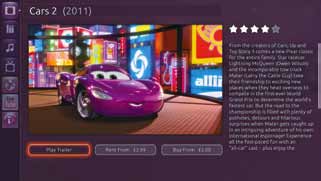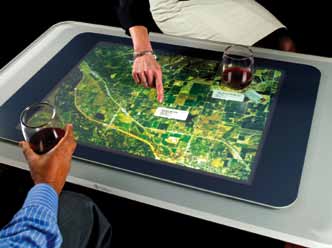Samsung’s new PNE8000 plasma series, and the UNES7500 and UNES8000 LED-based LCDs TVs have a built-in camera and microphone, so you can control the television by speaking or gesturing to it. Two remotes are also included. One is a standard multi-button type, while the other is a touchpad with a few buttons and a microphone.
But, voice training is a painful exercise with most voice-enabled devices like these. The system takes too long to train to the user’s voice. Repeated instructions to raise the volume might end up opening Skype—found a reviewer!
Gesture control appears to be a bit better. In the Samsung model, it is activated by holding a hand up in front of the TV. Then, you need to move your hand to guide a cursor, grab with your fist to make a selection, or make an anti-clockwise circular motion to undo. However, you need to have perfect, shadow-free lighting for gesture control.

LG has been showing off its magic remote controls for quite a few years now, every year adding more features to it. Last year, the company demonstrated gesture control for televisions. LG’s remote works similar to the Nintendo Wii, where users can use certain hand and arm gestures to operate the onscreen menus. For example, if you gesture a ‘V’ in the air, it brings up a list of recently watched videos. A wave of the remote can also cause the TV to switch from 2D to 3D and vice versa.
This year, the company has added voice recognition for text input, a scroll wheel and more magic gestures. The voice control system allows you to search for TV and Web content, and also access social media content. The voice features are powered by a platform from Nuance—the maker of Dragon Dictate, a popular Mac tool.
Both Samsung and LG have made a decent attempt at gesture and voice control but a lot more fine-tuning is needed before this goes mainstream.
Speaking of remotes, Canonical has launched a remote-less television called Ubuntu TV. Dubbed the television for human beings, Ubuntu TV has no remote. Users can work with touch or gesture control, or use their smartphone as a remote. The TV runs on the Ubuntu Linux operating system. It includes most Internet TV features like DVR abilities, access to online movies and TV shows, streaming capabilities and intelligent search. Ubuntu One, Ubuntu’s own cloud, will also be built into the new TV so that users can watch movies and TV shows stored on other devices.
Last year, a group of four students in Ahmedabad developed an innovative device called the Air Glove. The device won great acclaim at an inter-collegiate contest. It is an infrared-based gesture interface device that can be used as a remote control for televisions, air-conditioners, computers or any other appliance fitted with the Air Glove infrared interface. The device has an advantage over radio frequency based devices and can operate multiple appliances simultaneously. Moreover, the infrared technology has pin-point accuracy, making it more viable.

While the team demonstrated the concept with a large form-factor device, they are now developing a wrist-watch model.
Betting big on touch and gesture user interfaces
Microsoft Surface has already become a famed technology. The 360-degree interface uses PixelSense technology to see and respond to touch and gestures of real-world objects. It accepts over 50 simultaneous inputs, and has been used in the 102cm (40-inch) Samsung SUR40, which can be embedded on tables and walls.
Kinect, another Microsoft technology, has also made a mark. This motion-sensing input device for Xbox 360 and Windows PCs uses a webcam-like peripheral and associated software that lets users control and interact with the device through gestures and spoken commands. Microsoft hopes that Kinect will play a huge role in industries like healthcare, apart from interactive television and computer systems.
During a talk at CES, Steve Ballmer commented that Windows 8’s Metro user interface would drive a new magic that will make “one plus one equal three.” The Metro features a touch-enabled, tiled Start screen. Each tile represents an application and display information related to that application, such as the number of unread messages for an email application or the document currently being used on a wordprocessor. Metro applications can share information between them, and Microsoft hopes it to revolutionise cross-device user interfacing.
Indeed, there is a lot of focus on gesture-based computing these days, and hardware and software products are coming up to enable gesture-based user interfaces. San Francisco based Leap has introduced a small plastic device for enabling gesture applications on Mac. You need to simply plug the Leap into a USB port, load the Leap Motion software and calibrate the device by waving your arms as instructed. Having done that, the device becomes capable of tracking the motion of your hands or fingers very precisely (in the scale of around 1/100th of a millimetre), within a space of around 0.22 cubic metres (8 cubic feet).






